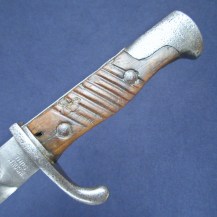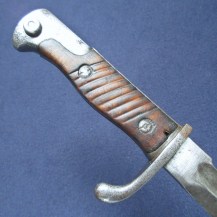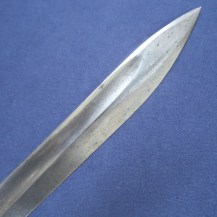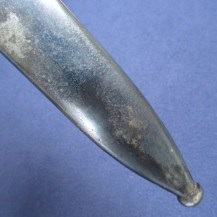German WW1 M1898/05 n.A. S.Abg 'Butcher' Bayonet, Dated 1916 by Simson & Co., Removed Sawback
Straight blade with distinctive ‘butcher blade’ profile, broadening towards the point with an upswept spine, 14½ inches long (19¾ inches overall). Wood scale grips with diagonally cut notches held by two screws, with oil hole. Steel hilt with quillon and partial muzzle ring, steel flash guard and steel pommel. Blued steel scabbard with frog hook.
The ricasso of the blade is stamped with the maker’s mark ‘Simson & Co. Suhl’. The spine of the blade is stamped with a crowned ‘W’ over ‘16’, indicating that the blade was manufactured in 1916, during the reign of Wilhelm II. There are stamped crown marks on the hilt and pommel.
The blade is bright, with only tiny areas of patination towards the point. There is light previously cleaned ‘peppered’ pitting to the ricasso, hilt, flash guard and pommel. One of the wood grips has a chip to one of its ‘ribs’. The scabbard retains a great deal of bluing and has only a couple of small dents on the frog hook side.
This is the ‘neu Art’ model of the 98/05 produced from early 1915, which incorporated a flash guard. These became standard on all wood-gripped German bayonets to prevent damage to the grips when firing the Karabiner 98 rifle with the bayonet fixed, something which had been rare before the war but was increasingly common due to the more widespread issue and carry of the carbine during WW1, particularly by assault troops. The all-steel scabbard is also correct for a wartime 98/05, the earlier leather scabbard with steel mounts having proved to be too fragile under field conditions.
This example was originally produced with a sawblade running along the spine of the blade. Standard German practice, following a Prussian rule, was for 6% of the bayonets to be made with the sawback, and issued to infantry NCOs, pioneers, and machine gun crews. Its purpose was to clear obstacles or brush, a successor to the fascine knife (faschinenmesser) of earlier eras. However, this example has had its saw blade removed during the war by an armourer, leaving a telltale ‘dip’ in the back of the blade.
Officially this was done because the saw was deemed unnecessary, especially as the British and French eventually replaced their wooden barbed wire posts with cast iron and there was little vegetation left to cut on most battlefields, but in fact the German command took notice of a pervasive rumour that German soldiers using them would be victimised if captured by Allied forces, on the basis that the saw blade was ‘inhumane’. There is no clear evidence that such ill-treatment actually took place, but there were instances of German soldiers refusing to go to the front line while equipped with sawback bayonets because of it, which would have been reason enough to reconsider their use.
After a survey in early 1917 by the Bavarian War Ministry found unanimous support from all units for their withdrawal, it cancelled all further production, restricted their use to pioneer units only, and recommended abolition to the General Staff. In September 1917 the Prussian War Ministry ordered all sawback bayonets be immediately withdrawn from frontline units, exchanged with non-sawback versions held by rear-echelon units, garrison troops or prison guards. Removal of the sawback by grinding began in early 1918 to make these usable on the front line once more, and any left in original condition by the war’s end were most likely destroyed by the Inter-Allied Military Control Commission.













